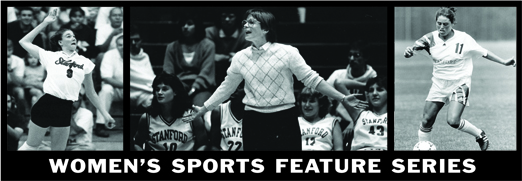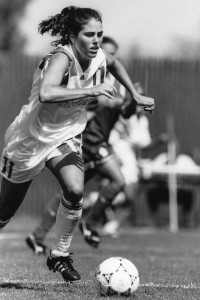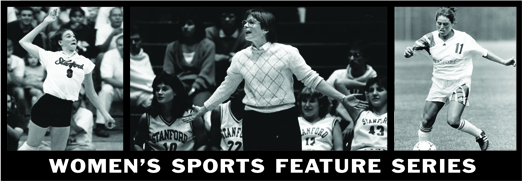This is the final part of a six-part feature series on Stanford women’s sports.

Julie Foudy ’93 was just one year old when the groundbreaking Title IX equality law, passed in the summer of 1972, kick-started a revolution in women’s college sports by enforcing a balance between the funding of men’s and women’s programs.
Looking back from the clarity of our position 40 years later, the impact of Title IX is obvious and striking, but in Foudy’s early childhood, the implications of the higher education equality law on women’s sports were not clear. The NCAA claimed its implementation was illegal and continued to resist its regulations until the 1981-82 season, when in a rush it introduced 12 new women’s sports, raising the total number from just two to 14.
Over the past two weeks, The Daily has told the story of Title IX and women’s sports at Stanford, from the program’s history to the experiences of both players and coaches.
Foudy’s story exemplifies how far we have come. Already a World Cup winner (1991), she was still unaware of the law’s implications when she received Stanford’s first ever women’s soccer scholarship in her senior year. As women’s sports began to receive a more equal footing, she went on to win two Olympic gold medals (1996, 2004), another World Cup (1999) and when she finally hung up her professional boots, she became a sports broadcaster. Completing the circle, she commentated for ESPN on Stanford’s first NCAA women’s soccer national title in 2011.
But enough of the past, now it’s time to look to the future.
***
The reality of college sports today is that memories of life four decades ago seem distant and hazy. The incessant four-year turnover of athletes and students ensures this, and all current college stars grew up long after most of the dust had settled on Title IX.
“The interesting thing to me is that the girls — at any school, for that matter — at this point, they have no idea what it was like,” said Anne Gould ’72 MA ’80, who coached the Stanford women’s tennis team from 1976-79. “You kind of expect a scholarship, you expect great coaching, you expect a trainer … it’s just a whole different ballgame.”
Current Stanford women’s basketball coach Tara VanDerveer agreed that female athletes today have far more opportunities that she did growing up in the 1950’s and 1960’s.
“[They] play on teams, travelling teams, high school teams, go to basketball camps,” VanDerveer said. “It really is all night and day, and I really would kill to trade places with any one of [my players].”
Growing up in the post-Title IX era, Olympic beach volleyball triple-gold medalist Kerri Walsh Jennings ’00 never even had to face the prejudices and lack of opportunity characteristic of previous generations.
“I had every single door opened for me, I think very much so because of Title IX, the house I was raised in and the situations I was presented with,” Walsh Jennings said. “I just consider myself an athlete, not a female athlete.”
While the war for equality in college sports seems won, there are, however, still battles being fought.
In 2002, thirty years after Title IX was born, the Commission on Opportunity in Athletics was put together to review its application and effects. It ultimately produced a report that Foudy, a member of the panel, was highly critical of. Together with two-time Olympic gold medalist swimmer Donna de Varona, she feared it laid too much blame on the law for the loss of men’s sports and it would roll back many of the gains made in collegiate athletics.
“Universities often used the excuse of Title IX when they talked about cutting programs,” Foudy explained. “[They] didn’t want to talk about the fact that they’re pouring money into programs that maybe aren’t making money, but they’re still going to try to pour money into them.”
The American Sports Council also unsuccessfully sued the Department of Education in 2011 over similar fears that the enforcement of quotas in high school could remove opportunities for boys to play sports and lead to the loss of boy’s teams.
Beyond the legal enforcement of equality in school sports, though, the media-driven perception of women’s sports still noticeably lags behind that of men’s, Take, for example, the case of Stanford’s two basketball teams.
Every single regular-season Stanford men’s game this year was screened live on television, but the same cannot be said of the women’s games. The men’s NIT loss to Alabama in March was broadcast on ESPN’s main channel, while the women’s clash with then-reigning national champions and No. 1 Baylor in November was omitted from the television schedule entirely. And though the No. 1 vs. No. 2 clash between Stanford and Connecticut late in December was picked up by ESPN, it was relegated to the ESPNU channel to make way for the New Era Pinstripe Bowl (ESPN) and the Kraft Fight Hunger Bowl (ESPN2).
***
Perhaps, though, it is now time to look beyond both Title IX and college athletics and concentrate on professional sports. University varsity programs help generate a huge pool of talent, but in comparison to male athletes, there exist relatively few opportunities for female athletes to turn their passions into careers.
The largest professional women’s sports league in the United States, the 12-team WNBA, lags considerably behind the 30-team NBA. ESPN’s new deal with the WNBA is worth $12 million a year; the NBA’s current deal with the same broadcaster is worth $930 million annually; $1 million per team compared to $31 million.
“I think that we’re behind,” VanDerveer said. “The men’s NCAA has been around for 75 years, we need more players playing, more really good players, and more opportunities for women. I think [athletic equality for women] has come a long way, but probably the media, the television exposure is an area [for improvement].”
The WNBA is, though, an exception to the rule. Stanford has had five players drafted in the first round of the WNBA draft in the last five years: Candice Wiggins ’08 (No. 3), Jayne Appel ’10 (No. 5), Kayla Pedersen ’11 (No. 7), Jeanette Pohlen ’11 (No. 9) and Nnemkadi Ogwumike ’12 (No. 1). Two of those players already have WNBA winner’s medals — Wiggins (Minnesota Lynx, 2011) and Pohlen (Indiana Fever, 2012) — and all are virtually guaranteed to be able to play out their careers as professionals. The same cannot be said of many other women’s sports.
“[Women’s success at the collegiate level] has to translate a little better to some of the other professional leagues,” said Stanford tennis head coach Lele Forood ’78. “Unfortunately, the soccer league can’t seem to stay afloat. So I guess that would be the next wave, where it can translate.”

In the 1990s, women’s soccer had unparalleled success in the USA, in stark contrast to its standing in more traditional soccer countries. U.S. women’s national team won the inaugural tournament in 1991 and then as hosts, won both the inaugural Olympic tournament in Atlanta in 1996 and the World Cup again at the end of the decade in 1999. Women’s soccer players became national heroes and household names, far more famous than their US men’s counterparts over that period: Foudy, Mia Hamm, Kristine Lilly, Brandi Chastain, Michelle Akers and others.
The hype generated by this success led to the founding of the Women’s United Soccer Association in February 2000, but three seasons later, in the week before the 2003 Women’s World Cup, the eight-team WUSA folded. A second attempt was made in 2009 with the Women’s Professional Soccer league, but that too suspended operations last year after just three seasons.
“Professional leagues are basically what the market can bear,” Foudy said. “It’s hard to create a sustainable model right now … but I do think we can get there. I don’t think the model is we have to look exactly like the men’s professional leagues, which I think is the mistake we make. Trying to grow too big too early.”
Hoping to learn from past mistakes, the third attempt to create a women’s professional league in the U.S. kicks off tomorrow, with FC Kansas City and Portland Thorns FC playing in the inaugural game of the new, eight-team National Women’s Soccer League. Former Stanford goalkeeper Nicole Barnhart ’04 will feature for Kansas City and defender Rachel Buehler ’07 is on the Portland team. Stanford’s presence will also be felt elsewhere in the league in Teresa Noyola ’12 (Seattle Reign FC), Kelley O’Hara ’10 (Sky Blue FC), Rachel Quon ’13 (Chicago Red Stars), Mariah Nogueira ’13 (Boston Breakers) and Alina Garciamendez ’13 (Washington Spirit).
Foudy believes that the key to the success of this new league may be its intention to try to avoid copying existing professional leagues too closely.
“There is a model out there that balances it, where you can create a really good product … an entertaining product and create a really loyal fan base,” Foudy said. “Maybe it’s not 80,000 [fans] a game, but maybe its 10,000, 15,000.”
This realization may be a sign that women’s sports are maturing to the point they no longer need to try to fashion themselves in the image of their male counterparts.
“People are comparing women less to men now, and just appreciating female athletes for who they are,” Walsh Jennings said, “I think those are really important trends — you can’t compare apples to oranges. That’s not fair to anybody.”
***
Foudy, Walsh Jennings and many other ex-Stanford stars and benefactors of Title IX have served as important role models for aspiring girls, exemplifying what they can achieve on the field or court and inspiring them to dream big.
“When you have that many kids playing and they have a chance to finally follow a team — I never had that chance — [and] have a chance to finally watch girls playing the sport in front of big crowds, that dream suddenly becomes much more realistic for them,” Foudy said.
But the future battlegrounds for athletic equality are no longer in college and the inspiration that Foudy and Walsh can give young girls may, on its own, not be enough. The challenge now is to tear down the barriers that persist in professional sports and focus the media spotlight more fairly on men’s and women’s athletics. The question is whether the Farm can play as key a role in that as it has in the revolution of college sports.
Seeking equality within a university like Stanford may be a noble cause, but without real opportunity in the world outside, it is not really equality at all.
Contact Tom Taylor at tom.taylor ‘at’ stanford.edu.
Previous installments in The Stanford Daily’s women’s sports feature series:
Women’s sports dominance began with ‘innovative’ approach in ’70s
University looks to promote equal support at all athletics events
Tara VanDerveer, mastermind of Maples
